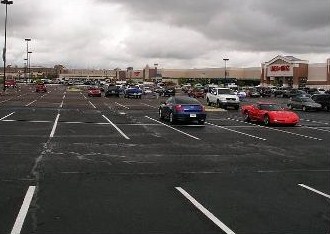As a young kid, skirting aimlessly throughout my suburban municipality from one car-optimized shopping center to the next on my bicycle in search of stimulation (and perhaps trouble), I vividly recall - though I likely didn't describe it as - the internal conflict between interesting commercial destinations on the inside, and the banal, cruel approach to these places on the outside. Although the primitive human desires of my psyche subconsciously longed for a central place to congregate with other lost children of the suburbs, I never had a downtown; I never had a community center. In this vacuum, I compensated with all that was available.
As a young kid, skirting aimlessly throughout my suburban municipality from one car-optimized shopping center to the next on my bicycle in search of stimulation (and perhaps trouble), I vividly recall - though I likely didn't describe it as - the internal conflict between interesting commercial destinations on the inside, and the banal, cruel approach to these places on the outside. Although the primitive human desires of my psyche subconsciously longed for a central place to congregate with other lost children of the suburbs, I never had a downtown; I never had a community center. In this vacuum, I compensated with all that was available.

Surely There's Something More to do With This
Take a drive into suburbia these days and you are bound to quickly encounter the awful effects of a non-plussed economy in the built form of wilting or abandoned shopping centers with weather stained facades, faded highway signs including store names that no longer exist, and crumbling parking lots designed to handle the best Black Friday in a nearly-bursted bubble boom year. Ignoring the sad result of decades of cheap, short-term development is not the solution to our sprawling woes. While I'm not one for the suburbs, plenty of people like them, so it's just not my style to insist that everyone should join me in the city. The single family home has its benefits (can you say "storage"), and who can argue that a little lebensraum isn't enjoyable? Nonetheless, letting density fall by the wayside as development skips along interstate exits and extends past the nostalgic hinterlands of our minds is a modern laissez-faire fallacy. Perhaps twenty years ago it may have seemed incomprehensible to do anything about the epidemic spread of strip malls and shopping centers; nowadays, a retrofit solution where highway-abutting parking lots are corralled with sidewalk-facing shops and big box retail stores on a five-hundred foot setback get a second, third, or fourth level of mixed office and residential may be more palatable if only there was the economic incentives to match those that originally allowed the first generation of development.
The idea is simple. On major arterials and highways violently parsed with endless curb-cuts where roadway capacity is high but congestion persists, shopping centers can be scheduled for a facelift by eating away at some of that "peak event" parking typically required by zoning codes along the parking lot perimeter. Usually, the edges along the highway are lined with de minimus sidewalks and various forms of sad landscaping and grass polygons. Replace these borders with two-floor retail and office combinations so that the swath of remaining parking spaces are effectively screened from the street by something more human;namely, people walking in and out of offices, shops, and restaurants along a sidewalk. Keep the driveways, keep the majority of parking, and keep the monster big box stores on the far end of the property. That would be step one.
Step two is a re-think of the big box structure itself so that the property can simultaneously add rateable property and utilize the mixed-use, shared parking argument to justify no increase – or a slight decrease – in overall parking spaces and traffic. To do this, build on top of the existing warehouse shell with residential units such as apartments and condominiums up to three or four more levels, or mix that with some office space on the second level. Use the rear of the buildings as alleyways for maintenance, trash collection, moving, vestibules with breezeways slicing through sections of big box monoliths, elevators to the upper levels, and some short-term visitor parking clear of the shopping activities up front. Throw in some landscaping in the parking lot and build out those original pitiful sidewalks abutting the storefront so that space is available for outdoor restaurant and cafe seating, and the property transforms into something more like a little village.
Do this a couple of times along a highway and suddenly densities exist to justify regular Bus Rapid Transit (BRT) service along corridors without ever disturbing the sanctity of subdivision neighborhoods situated further back along intersecting roadways. However, all these neighborhoods are now within walking and bicycling distance of fun little centers of activity that can serve as burgeoning community gathering places without the need for mom to chauffeur and all in safe proximity of home.
This is a thought, a concept kicked around the back of my mind since I discovered the profession of building ones own environment to suit. There is much to refine and many unanswered questions. One most immediately is how to build over a big box store in terms of structural capacity without brekaing the bank. Another notable question is exactly how do you entice a developer to retrofit a disintegrating chunk of failed suburbia into a new form that flies in the face of zoning code and, very likely, the community's image of how their municipality should look. In recent conversations with friends on the development side (they have plenty of free time at the moment), the general consensus was that there wasn't much room for profit in it. But if not, I asked, then how did the original, even less dense development get built? There is always - as there always is - a way. And if this can simultaneously bring a thicker artery to sparse, withering suburban flesh, while creating stimulating pockets of social congregation in exchange of the failed shopping malls of a prior century, perhaps we can discover a blending of urban and suburban philosophies so that coexistence can overcome the subjective debate between two fundamentally different forms of development.

Planetizen Federal Action Tracker
A weekly monitor of how Trump’s orders and actions are impacting planners and planning in America.

Chicago’s Ghost Rails
Just beneath the surface of the modern city lie the remnants of its expansive early 20th-century streetcar system.

Amtrak Cutting Jobs, Funding to High-Speed Rail
The agency plans to cut 10 percent of its workforce and has confirmed it will not fund new high-speed rail projects.

Ohio Forces Data Centers to Prepay for Power
Utilities are calling on states to hold data center operators responsible for new energy demands to prevent leaving consumers on the hook for their bills.

MARTA CEO Steps Down Amid Citizenship Concerns
MARTA’s board announced Thursday that its chief, who is from Canada, is resigning due to questions about his immigration status.

Silicon Valley ‘Bike Superhighway’ Awarded $14M State Grant
A Caltrans grant brings the 10-mile Central Bikeway project connecting Santa Clara and East San Jose closer to fruition.
Urban Design for Planners 1: Software Tools
This six-course series explores essential urban design concepts using open source software and equips planners with the tools they need to participate fully in the urban design process.
Planning for Universal Design
Learn the tools for implementing Universal Design in planning regulations.
Caltrans
City of Fort Worth
Mpact (founded as Rail~Volution)
City of Camden Redevelopment Agency
City of Astoria
City of Portland
City of Laramie






























